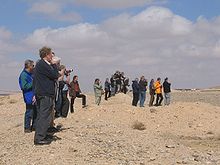Bill approach
The terms bogus arrival and photo stop describe the arrival of a (special) train as a staged event for photographers , videographers and spectators.

Usually the train stops in an interesting area or area typical of the route traveled. The passengers who want to watch the event from outside get out. Then the train sets back and then drives past the audience. After passing by, the train stops so that photographers and spectators can get back on and the journey continues.
Since staging photo stops and bogus approaches on a route with regular traffic can impair operations because such an event takes some time, i.e. uses a relatively large amount of route capacity , bogus trips and photo stops for railway enthusiasts are preferably carried out on routes with little traffic. Leaving the train on the open route may only take place if it does not pose a risk to passengers or the safety of rail operations.
For photo content, fixed conventions ideally apply among those involved. This creates a photo line so that the photographers are not in each other's picture. Under no circumstances should persons appear in the picture; a participating railway worker is tolerable if he is to be understood as part of the scenario. The train is prepared in such a way that the impression is created that it is actually in a real driving situation, for example all doors must be closed. Such rules mean that the images created on such an occasion are usually very similar.

